1993 CADILLAC FLEETWOOD lights
[x] Cancel search: lightsPage 201 of 386
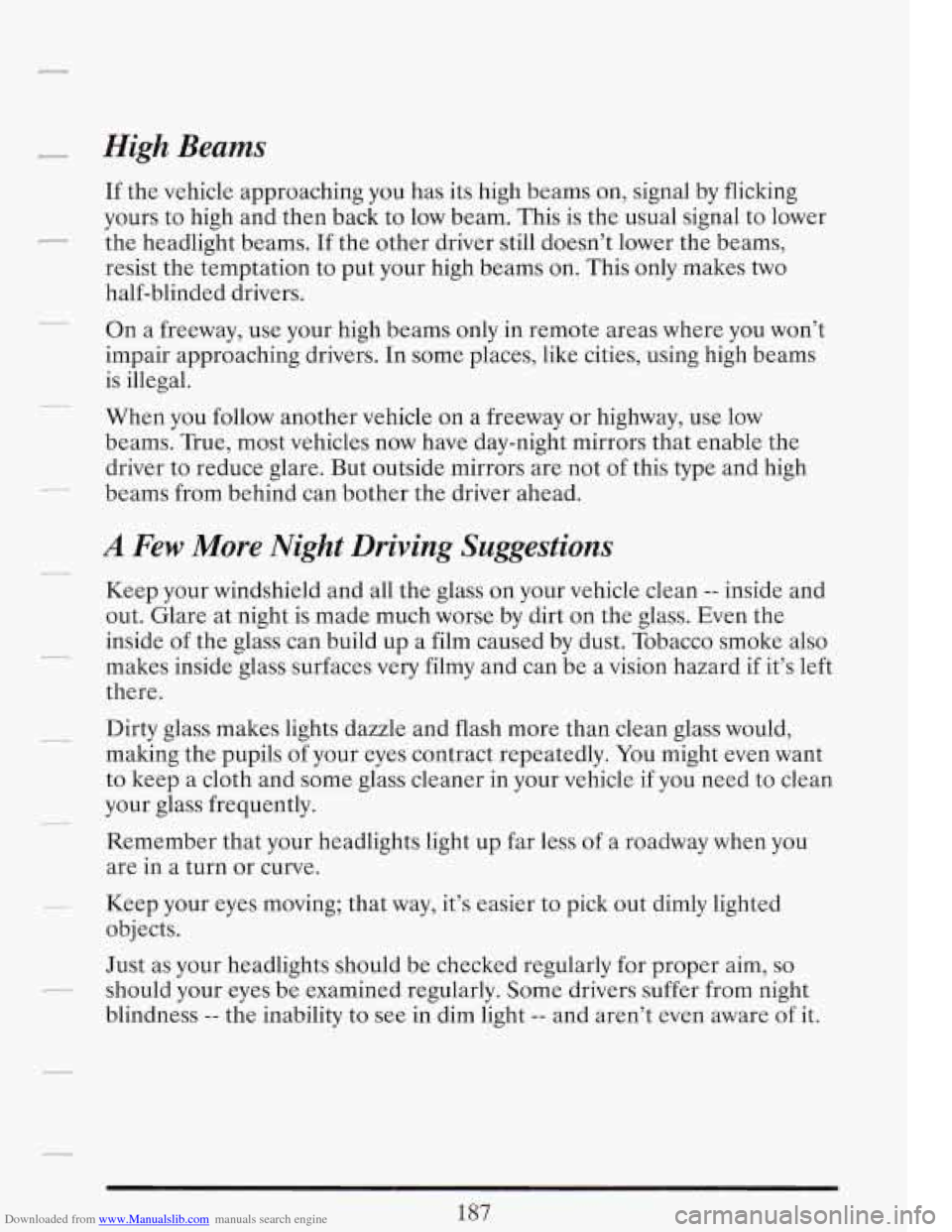
Downloaded from www.Manualslib.com manuals search engine r High Beams
If the vehicle approaching you has its high beams on, signal by flicking
yours to high and then back to low beam. This is the usual signal to lower
the headlight beams.
If the other driver still doesn’t lower the beams,
resist the temptation to put your high beams on. This only
makes two
half-blinded drivers.
- On a freeway, use your high beams only in remote areas where you won’t
impair approaching drivers. In some places, like cities, using high beams
is illegal.
When you follow another vehicle on a freeway or highway, use low
beams. True, most vehicles now have day-night mirrors that enable the
driver to reduce glare. But outside mirrors are not of this type and high
beams from behind can bother the driver ahead.
-
-
A Few More Night Driving Suggestions
-
Keep your windshield and all the glass on your vehicle clean -- inside and
out. Glare at night is made much worse by dirt on the glass. Even the
inside
of the glass can build up a film caused by dust. Tobacco smoke also
makes inside glass surfaces very filmy and can be a vision hazard
if it’s left
there. -
~ Dirty glass makes lights dazzle and flash more than clean glass would,
making the pupils
of your eyes contract repeatedly. You might even want
to keep a cloth and some glass cleaner in your vehicle if you need to clean
your glass frequently.
Remember that your headlights light up far less
of a roadway when you
are in a turn or curve.
-
_- Keep your eyes moving; that way, it’s easier to pick out dimly lighted
objects.
Just as your headlights should be checked regularly for proper aim, so
blindness
-- the inability to see in dim light -- and aren’t even aware of it.
- should your eyes be examined regularly. Some drivers suffer from night
187
Page 204 of 386
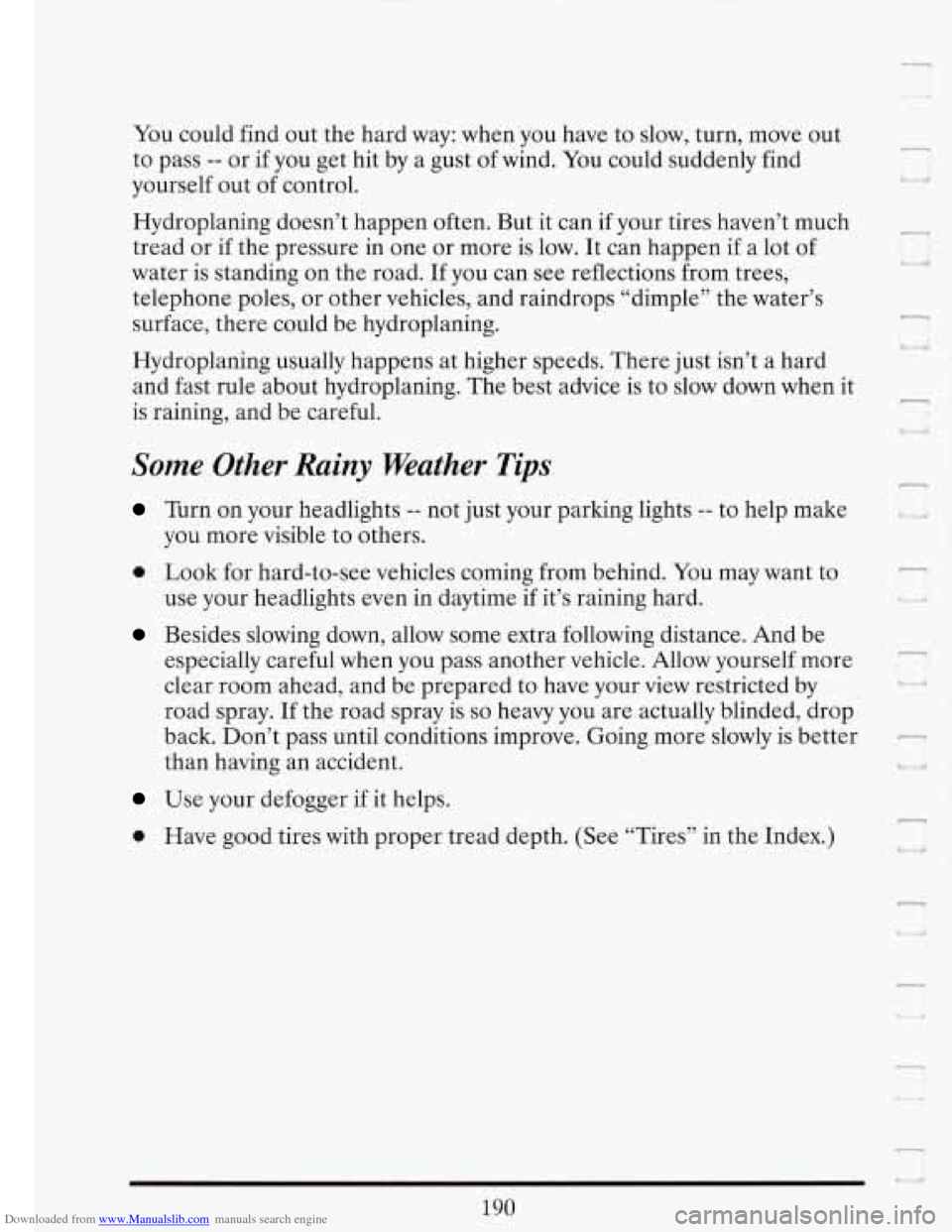
Downloaded from www.Manualslib.com manuals search engine You could find out the hard way: when you have to slow, turn, move out
to pass
-- or if you get hit by a gust of wind. You could suddenly find
yourself out of control.
Hydroplaning doesn’t happen often. But it can if your tires haven’t much
tread or if the pressure in one or more is low. It can happen if a lot of
water is standing on the road.
If you can see reflections from trees,
telephone poles, or other vehicles, and raindrops “dimple” the water’s
surface, there could be hydroplaning.
Hydroplaning usually. happens at higher speeds. There just isn’t a hard
and fast rule about hydroplaning. The best advice is to slow down when it
is raining, and be careful.
Some Other Rainy Weather Tips
Turn on your headlights -- not just your parlung lights -- to help make
you more visible to others.
0 Look for hard-to-see vehicles coming from behind. You may want to
use your headlights even in daytime if it’s raining hard.
Besides slowing down, allow some extra following distance. And be
especially careful when you pass another vehicle. Allow yourself more
clear room ahead, and be prepared to have your view restricted by
road spray.
If the road spray is so heavy you are actually blinded, drop
back. Don’t pass until conditions improve. Going more slowly is better
-
than having an accident. I
L1
I
Use your defogger if it helps.
0 Have good tires with proper tread depth. (See “Tires” in the Index.)
-
Y
190 I
Page 205 of 386
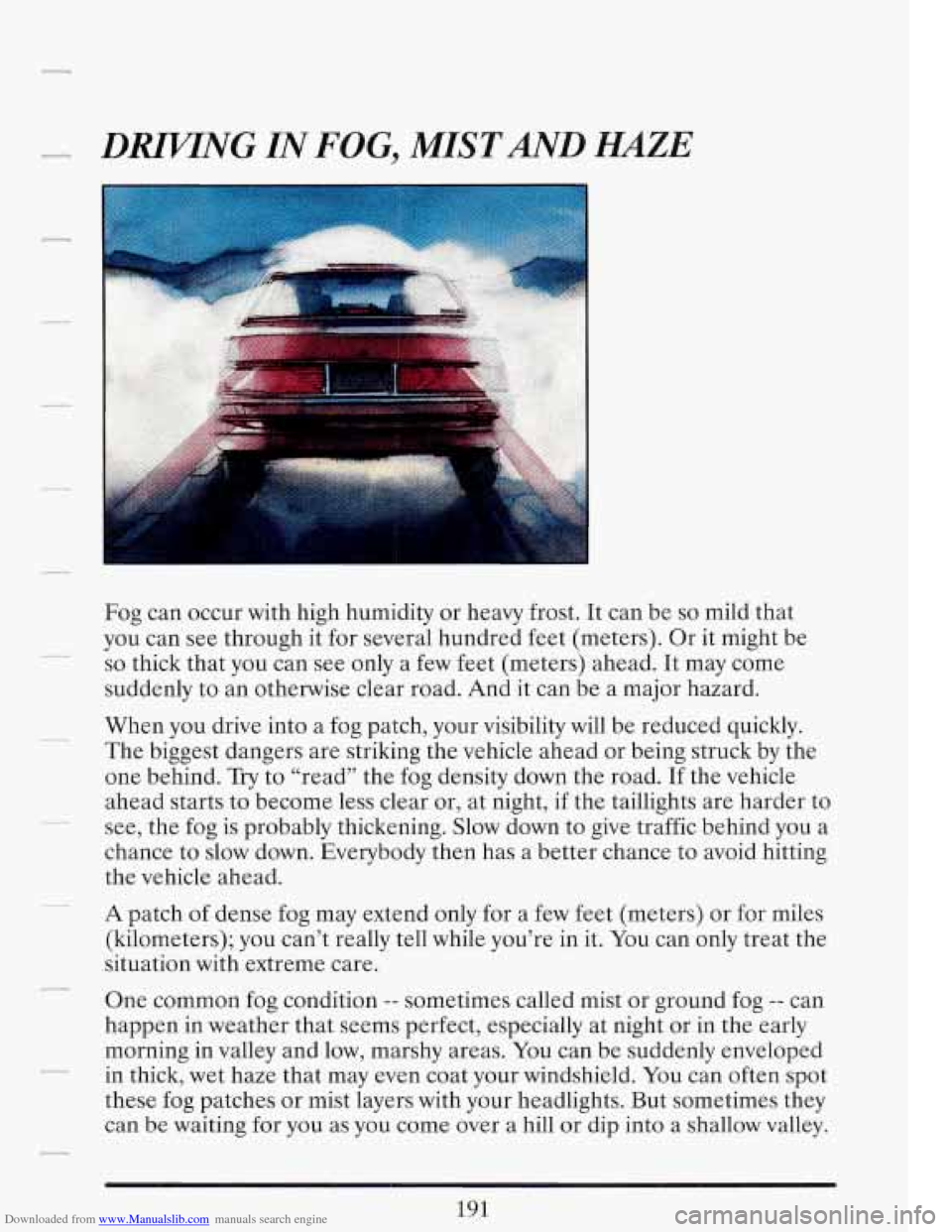
Downloaded from www.Manualslib.com manuals search engine DRZKNG IN FOG, MISTAND HAZE
Fog can occur with high humidity or heavy frost. It can be so mild that
you can see through it for several hundred feet (meters). Or it might be
so thick that you can see only a few feet (meters) ahead. It may come
suddenly to an otherwise clear road. And it can be a major hazard.
When you drive into a fog patch, your visibility will be reduced quickly.
The biggest dangers are striking the vehicle ahead or being struck by the
one behind.
Try to “read” the fog density down the road. If the vehicle
ahead starts to become less clear or, at night,
if the taillights are harder to
see, the fog is probably thickening. Slow down to give traffic behind you a
chance to slow down. Everybody then has a better chance to avoid hitting
the vehicle ahead.
A patch of dense fog may extend only for a few feet (meters) or for miles
(kilometers); you can’t really tell while you’re in it.
You can only treat the
situation with extreme care.
One common fog condition
-- sometimes called mist or ground fog -- can
happen in weather that seems perfect, especially at night or in the early
morning in valley and low, marshy areas.
You can be suddenly enveloped
in thick, wet haze that may even coat your windshield.
You can often spot
these fog patches or mist layers with your headlights. But sometimes they
can
be waiting for you as you come over a hill or dip into a shallow valley.
191
Page 210 of 386
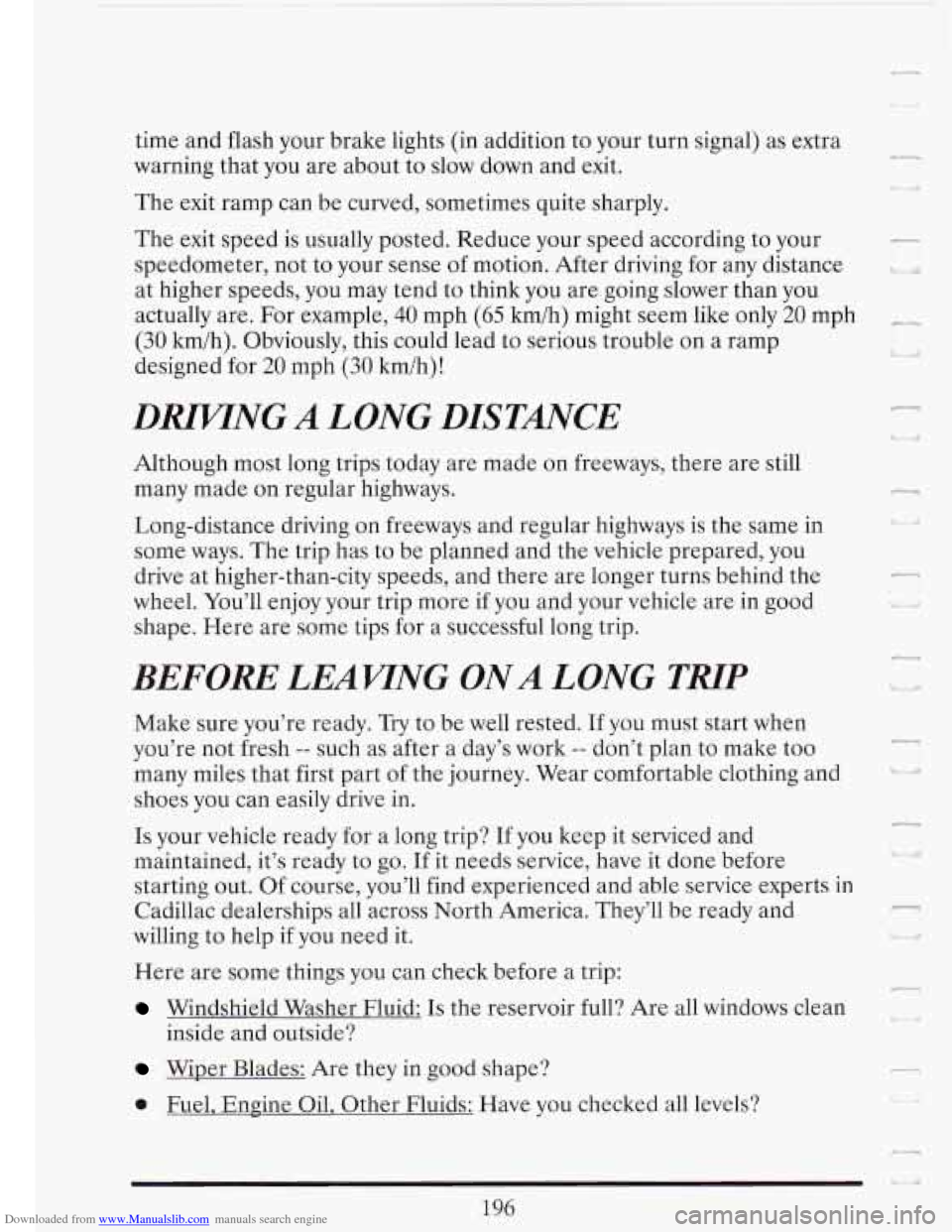
Downloaded from www.Manualslib.com manuals search engine time and flash your brake lights (in addition to your turn signal) as extra
warning that you are about to slow down and exit.
The exit ramp can be curved, sometimes quite sharply.
-.
U t I! The exit speed is usually posted. Reduce your speed according to your
speedometer, not to your sense
of motion. After driving for any distance
at higher speeds, you may tend to think you are going slower than you
actually are. For example,
40 mph (65 h/h) might seem like only 20 mph c_?
(30 km/h). Obviously, this could lead to serious trouble on a ramp
designed for
20 mph (30 kmih)!
I
L/
DRIVTNG A LONG DISTANCE
Although most long trips today are made on freeways, there are still
many made on regular highways.
Long-distance driving on freeways and regular highways is the same in
some ways. The trip has
to be planned and the vehicle prepared, you
drive at higher-than-city speeds, and there are longer turns behind the
wheel. You’ll enjoy your trip more if you and your vehicle are in good
shape. Here are some tips for a successful long trip.
BEFORE LEAWNG ONA LONG TRlP
Make sure you’re ready. Try to be well rested. If you must start when
you’re not fresh
-- such as after a day’s work -- don’t plan to make too
many miles that first part of the journey. Wear comfortable clothing and
shoes you can easily drive in.
.3
I
F i ! u
Is your vehicle ready for a long trip? If you keep it serviced and
maintained, it’s ready to
go. If it needs service, have it done before
starting out. Of course, you’ll find experienced and able service experts in
Cadillac dealerships all across North America. They’ll be ready and
7
willing to help if you need it. -1
Here are some things you can check before a trip:
Windshield Washer Fluid: Is the reservoir full? Are all windows clean
inside and outside?
Wiper Blades: Are they in good shape?
0 Fuel, Engine Oil, Other Fluids: Have you checked all levels?
Page 211 of 386
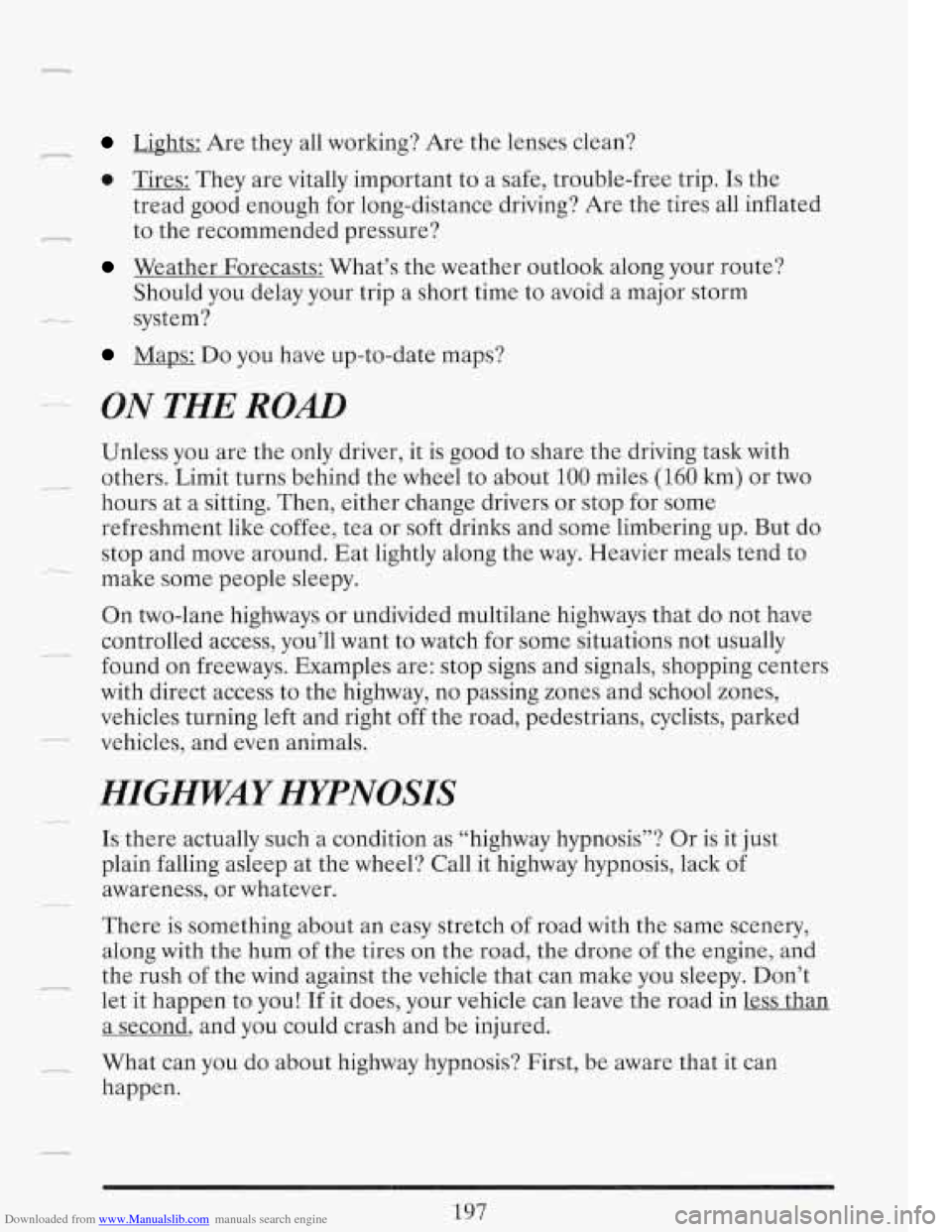
Downloaded from www.Manualslib.com manuals search engine - Lights: Are they all working? Are the lenses clean?
0 Tires: They are vitally important to a safe, trouble-free trip. Is the
tread good enough for long-distance driving? Are the tires all inflated
to the recommended pressure?
Weather Forecasts: What’s the weather outlook along your route?
Should you delay your trip a short time to avoid a major storm
system?
Maps: Do you have up-to-date maps?
_- - ON THE ROAD
Unless you are the only driver, it is good to share the driving task with
hours at a sitting. Then, either change drivers or stop for some
refreshment like coffee, tea or soft drinks and some limbering up. But do
stop and move around. Eat lightly along the way. Heavier meals tend
to
make some people sleepy.
- others. Limit turns behind the wheel to about 100 miles (160 km) or two
- ._
On two-lane highways or undivided multilane highways that do not have
controlled access, you’ll want to watch for some situations not usually
found on freeways. Examples are: stop signs and signals, shopping centers
with direct access to the highway,
no passing zones and school zones,
vehicles turning left and right off the road, pedestrians, cyclists, parked
vehicles, and even animals.
-
-
HIGWAY HYPNOSIS
c_
Is there actually such a condition as “highway hypnosis”? Or is it just
plain falling asleep at the wheel? Call it highway hypnosis, lack
of
awareness, or whatever.
There is something about an easy stretch of road with the same scenery,
along with the hum
of the tires on the road, the drone of the engine, and
- the rush of the wind against the vehicle that can make you sleepy. Don’t
let it happen
to you! If it does, your vehicle can leave the road in less than
a second, and you could crash and be injured.
happen.
__
- What can you do about highway hypnosis? First, be aware that it can
Page 221 of 386
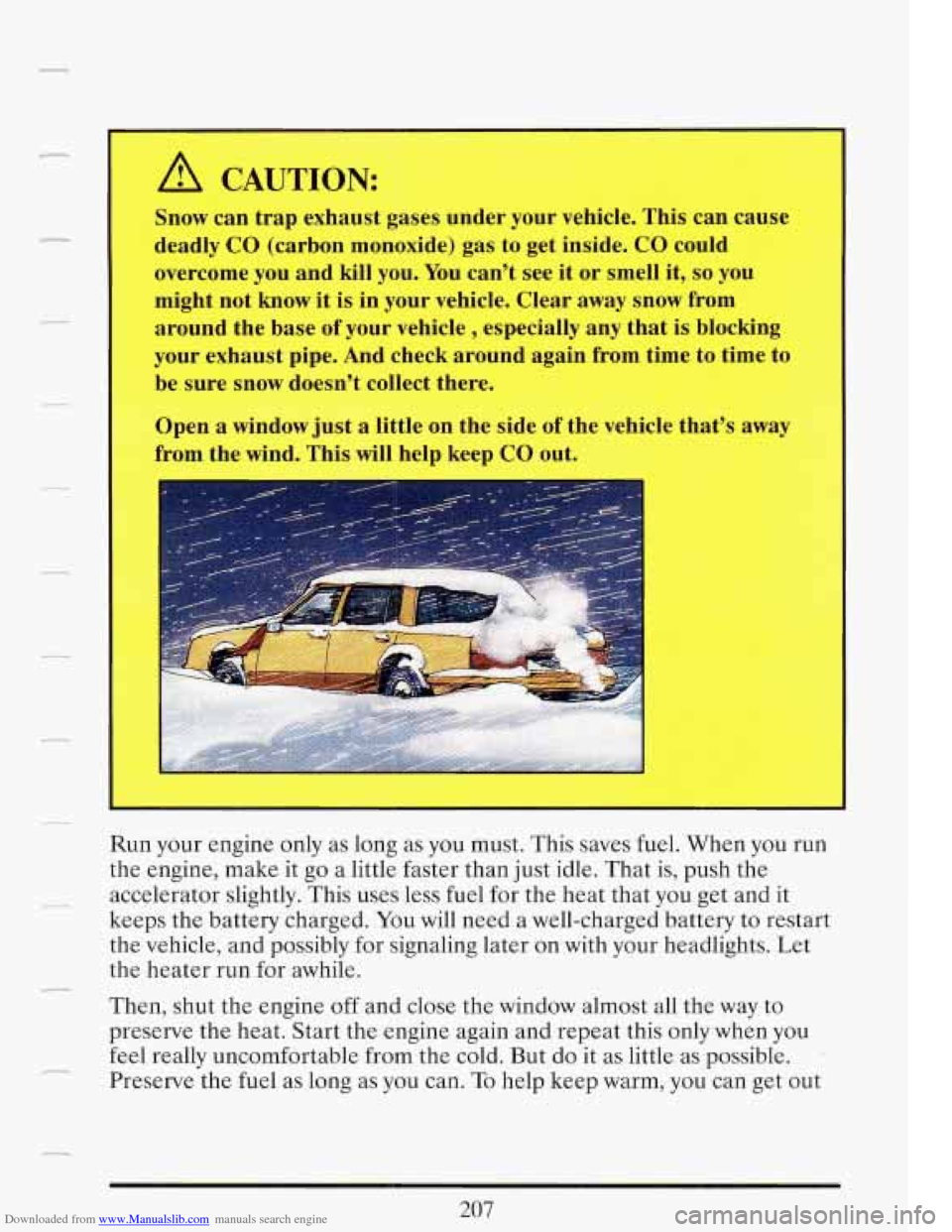
Downloaded from www.Manualslib.com manuals search engine A CAUTION:
Snow can trap exhaust gases under your vehicle. This can cause
deadly CO (carbon monoxide) gas to get inside. CO could
overcome you and kill you. You can’t see it or smell it,
so you
might not know it is in your vehicle. Clear away snow from
around the base
of your vehicle , especially any that is blocking
your exhaust pipe. And check around again from time to time to
be sure snow doesn’t collect there.
Open a window just a little on the side
of the vehicle that’s away
from the wind. This will help keep CO out.
Run your engine only as long as you must. This saves fuel. When you run
the engine, make it go a little faster than just idle. That is, push the
accelerator slightly. This uses less fuel for the heat that you get and it
keeps the battery charged. You
will need a well-charged battery to restart
the vehicle, and possibly for signaling later
on with your headlights. Let
the heater run for awhile.
207
Then, shut the engine off and close the window almost all the way to
preserve the heat. Start the engine again and repeat this only when you
feel really uncomfortable from the cold. But
do it as little as possible.
Preserve the fuel as long as you can. To help keep warm, you can get out
Page 226 of 386
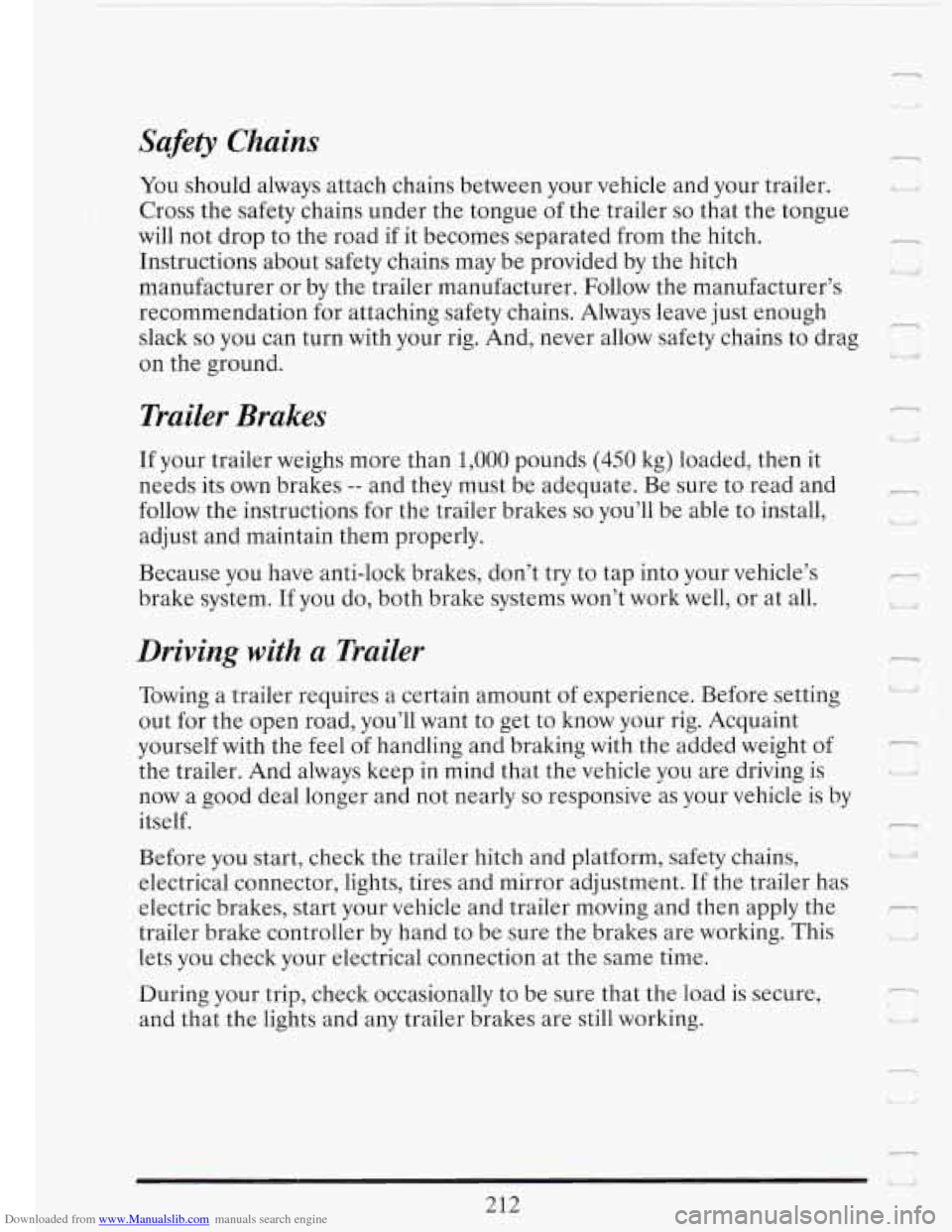
Downloaded from www.Manualslib.com manuals search engine Safety Chains
You should always attach chains between your vehicle and your trailer.
Cross the safety chains under the tongue
of the trailer so that the tongue
will not drop to the road if it becomes separated from the hitch.
Instructions about safety chains may be provided by the hitch
manufacturer or by the trailer manufacturer. Follow the manufacturer’s
recommendation for attaching safety chains. Always leave just enough
slack
so you can turn with your rig. And, never allow safety chains to drag
on the ground.
-
,-
Trailer Brakes
If your trailer weighs more than 1,000 pounds (450 kg) loaded, then it
needs its
own brakes -- and they must be adequate. Be sure to read and
follow the instructions for the trailer brakes
so you’ll be able to install,
adjust and maintain them properly.
Because
you have anti-lock brakes, don’t try to tap into your vehicle’s
brake system. If you do, both brake systems won’t work well, or at all.
Driving with a Trailer
Towing a trailer requires a certain amount of experience. Before setting
out for the open road, you’ll want to get to know your rig. Acquaint
yourself with the feel of handling and braking with the added weight of
the trailer. And always keep
in mind that the vehicle you are driving is
now a good deal longer and not nearly
so responsive as your vehicle is by
itself.
-
Before you start, check the trailer hitch and platform, safety chains, ..
electrical connector, lights, tires and mirror adjustment. If the trailer has
electric brakes, start your vehicle and trailer moving and then apply the
trailer brake controller by hand to be sure the brakes are working. This
lets you check your electrical connection at the same time.
During your trip, check occasionally to be sure that the load
is secure,
and that the lights and any trailer brakes are still working.
212
Page 227 of 386
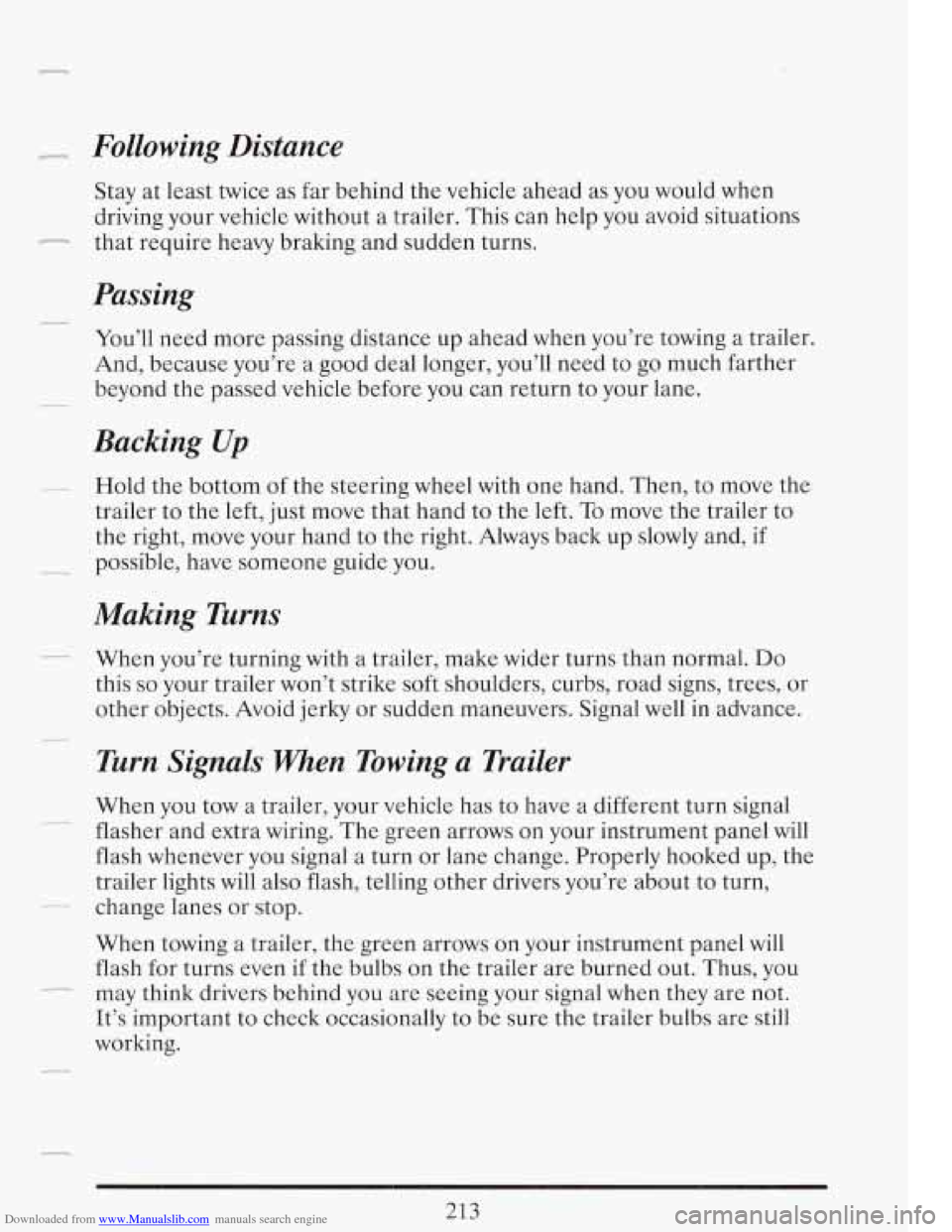
Downloaded from www.Manualslib.com manuals search engine - Following Distance
Stay at least twice as far behind the vehicle ahead as you would when
driving your vehicle without a trailer. This can help you avoid situations
- that require heavy braking and sudden turns.
Passing
I_
You’ll need more passing distance up ahead when you’re towing a trailer.
And, because you’re a good deal longer, you’ll need to go much farther
beyond the passed vehicle before you can return to your lane.
-
Backing Up
_- Hold the bottom of the steering wheel with one hand. Then, to move the
trailer to the left, just move that hand to the left.
To move the trailer to
the right, move your hand
to the right. Always back up slowly and, if
- possible, have someone guide you.
Making Turns
When you’re turning with a trailer, make wider turns than normal. Do
this so your trailer won’t strike soft shoulders, curbs, road signs, trees, or
other objects. Avoid jerky or sudden maneuvers. Signal well in advance.
1urn Signals When Towing a Trailer
When you tow a trailer, your vehicle has to have a different turn signal
flasher and extra wiring. The green arrows on your instrument panel will
flash whenever you signal a turn or lane change. Properly hooked up, the
trailer lights will also flash, telling other drivers you’re about to turn, -
- change lanes or stop.
213
When towing a trailer, the green arrows on your instrument panel will
flash for turns even
if the bulbs on the trailer are burned out. Thus, you
may think drivers behind you are seeing your signal when they are not.
It’s important to check occasionally to be sure the trailer bulbs are still
working. p__-_.